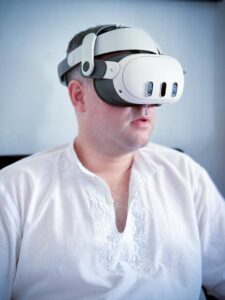Beyond ugly devices and dumb games.
VR is the Next Digital Revolution
Beyond Ugly Devices and Dumb Games
Introduction: The iPhone Moment of Today
In 2007, Apple unveiled the iPhone, a device that obliterated the boundaries of what a phone could be. It wasn’t just a gadget—it was a portal to your bank, music, research, and memories, all tucked into your pocket. As you’ve described, people lined up not for a product but for a new way of living, as apps transformed daily tasks into seamless digital experiences. Today, that same electric anticipation crackles around virtual reality (VR). By transporting users into immersive digital worlds through headsets, haptic gloves, and motion sensors, VR promises to redefine reality itself, much like the iPhone reshaped communication. Inspired by films like Minority Report (2002) and Surrogates (2009), VR is the spark of the next digital revolution, poised to turn skeptics into believers.
Cinematic Visions of Virtual Reality
Movies have long envisioned VR’s transformative power. In Minority Report, directed by Steven Spielberg, Tom Cruise’s character, John Anderton, uses gloves to manipulate data in a virtual space, predicting crimes with precise gestures. As you noted, this intuitive interface showcases VR’s potential to surpass smartphones, offering fluid control over digital environments. In Surrogates, directed by Jonathan Mostow, humans control perfect avatars, living adventures, romances, and even violence without physical risk. You highlighted how these avatars fulfill human desires by eliminating harm, but they also raise questions about identity and social disconnection, underscoring VR’s promise and ethical challenges.
The Promise of a Technological Revolution
Your comparison of VR to the iPhone’s 2007 debut captures its disruptive potential. Just as the iPhone replaced bank tellers, paper maps, and bulky cameras with apps, VR is set to consolidate and elevate experiences. Today’s VR landscape mirrors the chaotic, thrilling early days of smartphones. Tech giants like Apple, with its Vision Pro blending augmented and virtual reality, and Meta, with its affordable Quest series, are racing alongside Sony and Valve to craft the ultimate VR device. As you pointed out, these aren’t just headsets—they’re bets on a future where VR becomes as indispensable as smartphones. On platforms like X, users buzz with excitement over Vision Pro’s spatial computing while debating its price, echoing the iPhone’s $499 skepticism. Despite current devices being bulky and uncomfortable, VR is shedding its clunky reputation with lighter designs, better batteries, and AI-driven worlds, paving the way for a new way of living.
Technologies Shaping the VR Revolution
Advanced Haptic Interfaces
Haptic gloves and suits will let users “feel” virtual worlds, simulating textures, weights, and temperatures. Inspired by Minority Report’s gesture-based controls, these interfaces will enable natural interactions, revolutionizing fields like design, medicine, and gaming.
Integration with Artificial Intelligence
AI will power dynamic, personalized VR environments. Virtual assistants could guide users through educational simulations or adapt games in real-time, echoing Minority Report’s predictive systems and creating tailored experiences for every user.
Lightweight and Compact Displays
Bulky headsets will evolve into sleek glasses, akin to sunglasses, using micro-LED displays and ergonomic materials. As you envisioned, this shift will make VR as accessible as the iPhone, driving mass adoption.
5G and 6G Connectivity
Ultra-fast 5G and 6G networks will eliminate lag, enabling seamless multiplayer experiences. This connectivity will power shared virtual worlds, like the metaverse, aligning with your vision of a 3D digital future.
Personalized and Realistic Avatars
Drawing from Surrogates, hyper-realistic avatars will let users project idealized versions of themselves. 3D scanning and facial recognition will create digital representations for virtual meetings, gaming, or social interactions, redefining online identity.
Immersive Work and Education Environments
VR will transform offices and classrooms into interactive 3D spaces. As you imagined, students could dissect a frog in a virtual classroom with peers worldwide, while professionals collaborate in virtual boardrooms, boosting productivity and engagement.
Emerging Trends in VR
VR’s revolution extends beyond hardware, reshaping society in profound ways. Here are five emerging trends that align with your call to embrace innovation boldly.
Metaverse and Virtual Economies
The metaverse is creating digital economies where users buy virtual land, goods, and NFTs using cryptocurrencies. Platforms like Decentraland and The Sandbox, buzzing on X, let users own digital assets, supporting your vision of a 3D internet where businesses must rethink their presence.
Augmented Reality and Hybrid VR
VR is merging with augmented reality (AR) to create hybrid experiences. Devices like Apple’s Vision Pro overlay digital content onto the real world, enhancing tasks like navigation or design. This convergence, as you predicted, will make VR more versatile than smartphones.
Mental Health and Immersive Therapies
VR is revolutionizing mental health with therapies for anxiety, phobias, and stress. Virtual environments offer calming scenarios or controlled exposure to fears, aligning with your view of VR improving lives, much like the iPhone simplified communication.
Cultural Impact and Creative Expression
VR is transforming art and entertainment with virtual museum tours, interactive films, and 3D music creation. Imagine experiencing a concert in a virtual arena, as you described. This cultural shift supports your vision of VR redefining creativity and storytelling.
Sustainability and Inclusion
To achieve mass adoption, VR must be affordable and sustainable. Recyclable materials for headsets and energy-efficient metaverse servers are critical. As you suggested, accessibility will ensure VR reaches diverse populations, mirroring the iPhone’s global impact.
The 3D Future: A New Internet
As you envisioned, the shift from 2D content—websites, apps—to 3D experiences will be the next digital revolution, akin to how the internet transformed newspapers and books. Businesses, governments, and institutions will reinvent their content, creating immersive virtual stores, educational simulations, and social platforms. For instance, you could attend a concert front-row from your couch or collaborate in a virtual office, as you noted. This 3D internet will unlock economic opportunities but demand bold adaptation from all sectors.
Challenges and Opportunities
VR faces hurdles, just as the iPhone did with spotty 3G and no initial app store. You highlighted motion sickness, high costs, and limited mainstream appeal beyond gaming as current challenges. Solutions are emerging: ergonomic headsets, nausea-reducing software, and 5G for seamless experiences. Surrogates warns of social isolation through avatar-driven lives, while Minority Report raises privacy concerns with predictive systems. Yet, as you emphasized, for audacious early adopters, embracing VR now offers a chance to shape the future, just as iPhone pioneers defined the smartphone era, despite risks like investing in evolving tech.
Conclusion: Step Into the Future
Remember the moment you held a smartphone and realized the world had changed? As you described, the iPhone wasn’t just about apps—it was banking, navigating, and connecting from your pocket, killing bulky monitors and reshaping industries. VR is that next spark, poised to rewrite how we live, work, and play. From virtual classrooms that feel real to meetings where you’re “there” without leaving home, the revolution is here. X is alive with chatter about Vision Pro and metaverse startups, echoing the iPhone’s early buzz. Don’t be the caveman marveling at others’ VR glasses like a spaceship. Jump in early, as you urged, because VR’s pioneers are building a new reality. Follow my blog and social media to stay ahead of this transformation, share your VR journey, and let’s shape the future together!



